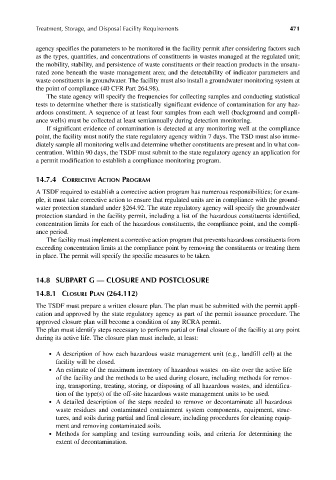Page 500 - Materials Chemistry, Second Edition
P. 500
CAT3525_C14.qxd 1/27/2005 12:37 PM Page 471
Treatment, Storage, and Disposal Facility Requirements 471
agency specifies the parameters to be monitored in the facility permit after considering factors such
as the types, quantities, and concentrations of constituents in wastes managed at the regulated unit;
the mobility, stability, and persistence of waste constituents or their reaction products in the unsatu-
rated zone beneath the waste management area; and the detectability of indicator parameters and
waste constituents in groundwater. The facility must also install a groundwater monitoring system at
the point of compliance (40 CFR Part 264.98).
The state agency will specify the frequencies for collecting samples and conducting statistical
tests to determine whether there is statistically significant evidence of contamination for any haz-
ardous constituent. A sequence of at least four samples from each well (background and compli-
ance wells) must be collected at least semiannually during detection monitoring.
If significant evidence of contamination is detected at any monitoring well at the compliance
point, the facility must notify the state regulatory agency within 7 days. The TSD must also imme-
diately sample all monitoring wells and determine whether constituents are present and in what con-
centration. Within 90 days, the TSDF must submit to the state regulatory agency an application for
a permit modification to establish a compliance monitoring program.
14.7.4 CORRECTIVE ACTION PROGRAM
A TSDF required to establish a corrective action program has numerous responsibilities; for exam-
ple, it must take corrective action to ensure that regulated units are in compliance with the ground-
water protection standard under §264.92. The state regulatory agency will specify the groundwater
protection standard in the facility permit, including a list of the hazardous constituents identified,
concentration limits for each of the hazardous constituents, the compliance point, and the compli-
ance period.
The facility must implement a corrective action program that prevents hazardous constituents from
exceeding concentration limits at the compliance point by removing the constituents or treating them
in place. The permit will specify the specific measures to be taken.
14.8 SUBPART G — CLOSURE AND POSTCLOSURE
14.8.1 CLOSURE PLAN (264.112)
The TSDF must prepare a written closure plan. The plan must be submitted with the permit appli-
cation and approved by the state regulatory agency as part of the permit issuance procedure. The
approved closure plan will become a condition of any RCRA permit.
The plan must identify steps necessary to perform partial or final closure of the facility at any point
during its active life. The closure plan must include, at least:
● A description of how each hazardous waste management unit (e.g., landfill cell) at the
facility will be closed.
● An estimate of the maximum inventory of hazardous wastes on-site over the active life
of the facility and the methods to be used during closure, including methods for remov-
ing, transporting, treating, storing, or disposing of all hazardous wastes, and identifica-
tion of the type(s) of the off-site hazardous waste management units to be used.
● A detailed description of the steps needed to remove or decontaminate all hazardous
waste residues and contaminated containment system components, equipment, struc-
tures, and soils during partial and final closure, including procedures for cleaning equip-
ment and removing contaminated soils.
● Methods for sampling and testing surrounding soils, and criteria for determining the
extent of decontamination.

